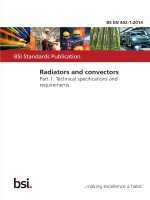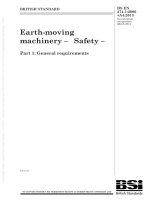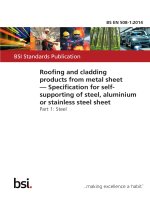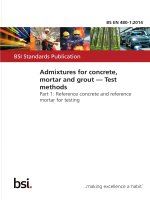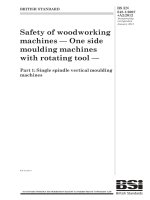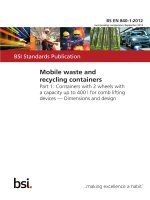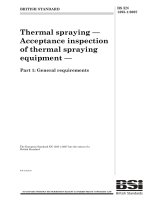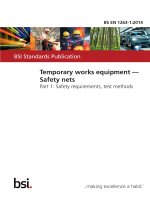Bsi bs en 61730 1 2007 + a11 2014
Bạn đang xem bản rút gọn của tài liệu. Xem và tải ngay bản đầy đủ của tài liệu tại đây (1.85 MB, 22 trang )
BRITISH STANDARD
Photovoltaic (PV)
module safety
qualification —
Part 1: Requirements for construction
ICS 27.160
BS EN
61730-1:2007
+A11:2014
BS EN 61730-1:2007+A11:2014
National foreword
This British Standard is the UK implementation of
EN 61730-1:2007+A11:2014. It is derived from IEC 61730-1:2004,
incorporating amendment 1:2011 and amendment 2:2013. It supersedes
BS EN 61730-1:2007+A2:2013, which is withdrawn.
The start and finish of text introduced or altered by amendment is
indicated in the text by tags. Tags indicating changes to IEC text carry
the number of the IEC amendment. For example, text altered by IEC
amendment 1 is indicated by !".
Where a common modification has been introduced by CENELEC amendment,
the tags carry the number of the amendment. For example, the common
modifications introduced by CENELEC amendment A11 are indicated by
hi.
The CENELEC common modifications have been implemented at the
appropriate places in the text. The start and finish of each common
modification is indicated in the text by tags }~.
The UK participation in its preparation was entrusted to Technical
Committee GEL/82, Photovoltaic Energy Systems.
A list of organizations represented on this committee can be obtained on
request to its secretary.
This publication does not purport to include all the necessary provisions
of a contract. Users are responsible for its correct application.
Compliance with a British Standard cannot confer immunity
from legal obligations.
This British Standard was
published under the authority
of the Standards Policy and
Strategy Committee
on 31 July 2007
© The British Standards
Institution 2015.
Published by BSI Standards
Limited 2015
ISBN 978 0 580 86345 5
Amendments/corrigenda issued since publication
Date
Comments
30 April 2012
Implementation of IEC amendment 1:2011 with
CENELEC endorsement A1:2012. Additional
references added to Annex ZA.
31 August 2013
Implementation of IEC amendment 2:2013 with
CENELEC endorsement A2:2013
31 January 2015
Implementation of IEC amendment 11:2014 with
CENELEC endorsement A11:2014
EN 61730-1:2007+A11
EUROPEAN STANDARD
NORME EUROPÉENNE
EUROPÄISCHE NORM
November 2014
ICS 27.160
English version
Photovoltaic (PV) module safety qualification –
Part 1: Requirements for construction
(IEC 61730-1:2004, modified)
Qualification pour la sûreté de
fonctionnement des modules
photovoltaïques (PV) –
Partie 1: Exigences pour la construction
(CEI 61730-1:2004, modifiée)
Photovoltaik (PV) -Module –
Sicherheitsqualifikation –
Teil 1: Anforderungen an den Aufbau
(IEC 61730-1:2004, modifiziert)
This European Standard was approved by CENELEC on 2007-02-01. CENELEC members are bound to comply
with the CEN/CENELEC Internal Regulations which stipulate the conditions for giving this European Standard
the status of a national standard without any alteration.
Up-to-date lists and bibliographical references concerning such national standards may be obtained on
application to the Central Secretariat or to any CENELEC member.
This European Standard exists in three official versions (English, French, German). A version in any other
language made by translation under the responsibility of a CENELEC member into its own language and notified
to the Central Secretariat has the same status as the official versions.
CENELEC members are the national electrotechnical committees of Austria, Belgium, Bulgaria, Cyprus, the
Czech Republic, Denmark, Estonia, Finland, France, Germany, Greece, Hungary, Iceland, Ireland, Italy, Latvia,
Lithuania, Luxembourg, Malta, the Netherlands, Norway, Poland, Portugal, Romania, Slovakia, Slovenia, Spain,
Sweden, Switzerland and the United Kingdom.
CENELEC
European Committee for Electrotechnical Standardization
Comité Européen de Normalisation Electrotechnique
Europäisches Komitee für Elektrotechnische Normung
Central Secretariat: rue de Stassart 35, B - 1050 Brussels
© 2007 CENELEC -
All rights of exploitation in any form and by any means reserved worldwide for CENELEC members.
Ref. No. EN 61730-1:2007 E
BS EN 61730-1:2007+A11:2014
EN 61730-1:2007+A11:2014 (E)
–2–
Foreword
The text of document 82/356/FDIS, future edition 1 of IEC 61730-1, prepared by IEC TC 82, Solar
photovoltaic energy systems, was submitted to the IEC-CENELEC parallel vote.
A draft amendment, prepared by the Technical Committee CENELEC TC 82, Solar photovoltaic energy
systems, was submitted to the Unique Acceptance Procedure.
The combined texts were approved by CENELEC as EN 61730-1 on 2007-02-01.
The following dates were fixed:
– latest date by which the EN has to be implemented
at national level by publication of an identical
national standard or by endorsement
(dop)
2008-02-01
– latest date by which the national standards conflicting
with the EN have to be withdrawn
(dow)
2010-02-01
Annex ZA has been added by CENELEC.
_________
Endorsement notice
The text of the International Standard IEC 61730-1:2004 was approved by CENELEC as a European
Standard with agreed common modifications.
_________
Foreword to amendment A1
The text of document 82/659A/FDIS, future edition 1 of IEC 61730-1:2004/A1, prepared by IEC/TC 82,
"Solar photovoltaic energy systems" was submitted to the IEC-CENELEC parallel vote and approved by
CENELEC as EN 61730-1:2007/A1:2012.
The following dates are fixed:
•
•
latest date by which the document has
to be implemented at national level by
publication of an identical national
standard or by endorsement
latest date by which the national
standards conflicting with the
document have to be withdrawn
(dop)
2012-09-19
(dow)
2014-12-19
Attention is drawn to the possibility that some of the elements of this document may be the subject of
patent rights. CENELEC [and/or CEN] shall not be held responsible for identifying any or all such patent
rights.
Endorsement notice
The text of the International Standard IEC 61730-1:2004/A1:2011 was approved by CENELEC as a
European Standard without any modification.
BS EN 61730-1:2007+A11:2014
EN 61730-1:2007+A11:2014 (E)
–3–
Foreword to amendment A2
The text of document 82/754/FDIS, future amendment 2 to edition 1 of IEC 61730-1, prepared by
IEC/TC 82 "Solar photovoltaic energy systems" was submitted to the IEC-CENELEC parallel vote and
approved by CENELEC as EN 61730-1:2007/A2:2013.
The following dates are fixed:
•
latest date by which the document has
to be implemented at national level by
publication of an identical national
standard or by endorsement
(dop)
2014-01-18
•
latest date by which the national
standards conflicting with the
document have to be withdrawn
(dow)
2016-04-18
Attention is drawn to the possibility that some of the elements of this document may be the subject of
patent rights. CENELEC [and/or CEN] shall not be held responsible for identifying any or all such
patent rights.
This standard covers the Principle Elements of the Safety Objectives for Electrical Equipment
Designed for Use within Certain Voltage Limits (LVD - 2006/95/EC).
Endorsement notice
The text of the International Standard IEC 61730-1:2004/A2:2013 was approved by CENELEC as a
European Standard without any modification.
Foreword to amendment A11
This document (EN 61730:2007/A11:2014) has been prepared by CLC/TC 82 "Solar photovoltaic
energy systems".
The following dates are fixed:
•
•
latest date by which this document has to be
implemented at national level by publication of
an identical national standard or by
endorsement
latest date by which the national standards
conflicting with this document have to
be withdrawn
(dop)
2015-10-13
(dow)
2017-10-13
Attention is drawn to the possibility that some of the elements of this document may be the subject of
patent rights. CENELEC [and/or CEN] shall not be held responsible for identifying any or all such
patent rights.
BS EN 61730-1:2007+A11:2014
EN 61730-1:2007+A11:2014 (E)
–4–
Annex ZA
(normative)
Normative references to international publications
with their corresponding European publications
The following referenced documents are indispensable for the application of this document. For dated
references, only the edition cited applies. For undated references, the latest edition of the referenced
document (including any amendments) applies.
NOTE When an international publication has been modified by common modifications, indicated by (mod), the relevant EN/HD
applies.
Publication
–
Year
–
Title
Datasheet and nameplate information for
photovoltaic modules
IEC 60065
-
Audio, video and similar electronic apparatus - EN 60065
Safety requirements
-
IEC 60112
– 1)
Method for the determination of the proof and EN 60112
the comparative tracking indices of solid
insulating materials
2003 2)
IEC 60189-2
–1)
Low-frequency cables and wires with PVC
insulation and PV sheath –
Part 2: Cables in pairs, triples, quads and
quintuples for inside installations
–
–
IEC 60216-1
–1)
Electrical insulating materials - Properties of
thermal endurance –
Part 1: Ageing procedures and evaluation of
test results
EN 60216-1
20012)
IEC 60216-5
–1)
Electrical insulating materials - Thermal
endurance properties –
Part 5: Determination of relative thermal
endurance index (RTE) of an insulating
material
EN 60216-5
20032)
IEC 60364-5-51
(mod)
–1)
Electrical installations of buildings –
EN 60364-5-51
Part 5-51: Selection and erection of electrical
equipment - Common rules
20062)
IEC 60417
database
Graphical symbols for use on equipment
–
–
IEC 60512-5-1
–1)
Connectors for electronic equipment - Tests
and measurements –
Part 5-1: Current-carrying capacity tests Test 5a: Temperature rise
EN 60512-5-1
20022)
IEC 60512-5-2
–1)
Connectors for electronic equipment - Tests
and measurements –
Part 5-2: Current-carrying capacity tests Test 5b: Current-temperature derating
EN 60512-5-2
20022)
IEC 60529
–1)
Degrees of protection provided by enclosures EN 60529
(IP Code)
+ corr. May
19912)
1993
IEC 60587
-
Electrical insulating materials used under
EN 60587
severe ambient conditions - Test methods for
evaluating resistance to tracking and erosion
-
1)
2)
Undated reference.
Valid edition at date of issue.
EN/HD
EN 50380
Year
2003
–5–
BS EN 61730-1:2007+A11:2014
EN 61730-1:2007+A11:2014 (E)
Publication
IEC 60664-1
Year
–1)
Title
Insulation coordination for equipment within
low-voltage systems –
Part 1: Principles, requirements and tests
IEC 60695-1-1
–1)
EN 60695-1-1
Fire hazard testing –
Part 1-1: Guidance for assessing the fire
hazard of electrotechnical products - General
guidelines
20002)
IEC 60695-2-10
-
Fire hazard testing EN 60695-2-10
Part 2-10: Glowing/hot-wire based test
methods - Glow-wire apparatus and common
test procedure
-
IEC 60695-2-20
-
Fire hazard testing Part 2: Glowing/hot-wire based test methods Section 20: Hot-wire coil ignitability test on
materials
-
IEC 60695-11-10
-
Fire hazard testing EN 60695-11-10
Part 11-10: Test flames - 50 W horizontal and
vertical flame test methods
-
IEC 60695-11-20
-
Fire hazard testing Part 11-20: Test flames - 500 W flame test
methods
EN 60695-11-20
-
IEC 60947-1
–1)
Low-voltage switchgear and controlgear –
Part 1: General rules
EN 60947-1
+ corr. November
20042)
2004
IEC 61140
2001
Protection against electric shock - Common
aspects for installation and equipment
EN 61140
2002
IEC 61215
–1)
Crystalline silicon terrestrial photovoltaic (PV) EN 61215
modules - Design qualification and type
approval
20052)
IEC 61646
–1)
Thin-film terrestrial photovoltaic (PV) modules EN 61646
- Design qualification and type approval
19972)
IEC 61721
–
Susceptibility of a photovaltaic (PV) module –
to accidental impact damage (resistance to
impact test)
–
Photovoltaic (PV) module safety qualification - EN 61730-2
- Part 2: Requirements for testing
2007
–
Connectors for photovoltaic systems - Safety –
requirements and tests
–i
ISO 261
–1)
ISO general purpose metric screw threads General plan
–
–
ISO 262
–1)
ISO general purpose metric screw threads Selected sizes for screws, bolts and nuts
–
–
ISO 4892
Series Plastics – Methods of exposure to laboratory EN ISO 4892
light sources
Series
ANSI Z97.1
–1)
–
–
ASTM D2303-97
–
–
–
ASTM E162-02a
–1)
Standard Test Method for Surface
Flammability of Materials Using a Radiant
Heat Energy Source
–
–
Junction boxes for photovoltaic modules
–
– i
IEC 61730-2 (mod) 2004
h EN 50521 + A1
h EN 50548 + A1 + A2 –
American National Standard for Safety
Glazing Materials Used in Buildings - Safety
Performance Specifications and Methods of
Test
Standard Test Methods for Liquid-Contaminant
Inclined-Plane Tracking and Erosion of
Insulating Materials
EN/HD
EN 60664-1
Year
20032)
BS EN 61730-1:2007+A11:2014
EN 61730-1:2007+A11:2014 (E)
–6–
CONTENTS
1
Scope and object............................................................................................................7
2
Normative references .....................................................................................................7
3
Application classes .........................................................................................................7
4
3.1 General .................................................................................................................7
3.2 Class A: General access, hazardous voltage, hazardous power applications ...........8
3.3 Class B: Restricted access, hazardous voltage, hazardous power applications .......8
3.4 Class C: Limited voltage ........................................................................................8
Construction requirements ..............................................................................................8
5
4.1 General requirements ............................................................................................8
4.2 Metal parts ............................................................................................................ 8
Polymeric materials ........................................................................................................9
6
5.1 General .................................................................................................................9
5.2 Polymers serving as an enclosure for live parts ......................................................9
5.3 Polymers serving to support live parts ..................................................................10
5.4 Polymers serving as an outer surface...................................................................10
5.5 Barriers ...............................................................................................................11
5.6 Structural glazing materials..................................................................................11
Internal wiring and current-carrying parts ......................................................................11
7
6.1 Internal wiring......................................................................................................11
6.2 Splices ................................................................................................................ 11
6.3 Mechanical securement .......................................................................................11
Connections ................................................................................................................. 11
7.1
7.2
7.3
7.4
h 7.5
Field connections – general requirements ............................................................11
Field wiring terminals ...........................................................................................12
Connectors ..........................................................................................................12
Output lead or cables...........................................................................................13
Junction boxes .....................................................................................................13 i
8
Bonding and grounding .................................................................................................13
9
Creepage and clearance distances ...............................................................................14
hText deletedi
11 Marking ........................................................................................................................15
12 Requirements for supplied documents...........................................................................16
13 Modifications ................................................................................................................17
Bibliography .......................................................................................................................18
–7–
BS EN 61730-1:2007+A11:2014
IEC 61730-1:2007+A11:2014 (E)
PHOTOVOLTAIC (PV) MODULE SAFETY QUALIFICATION –
Part 1: Requirements for construction
1 Scope and object
This part of }EN 61730~ describes the fundamental construction requirements for photovoltaic
(PV) modules in order to provide safe electrical and mechanical operation during their expected
lifetime. Specific topics are provided to assess the prevention of electrical shock, fire hazards,
and personal injury due to mechanical and environmental stresses. This part of }EN 61730~
pertains to the particular requirements of construction. }EN 61730-2~ outlines the requirements
of testing.
This standard attempts to define the basic requirements for various application classes of PV
modules, but it cannot be considered to encompass all national or regional building codes.
The specific requirements for marine and vehicle applications are not covered. This standard
is not applicable to modules with integrated AC inverters (AC modules).
This standard is designed so that its test sequence can coordinate with those of IEC 61215 or
IEC 61646, so that a single set of samples may be used to perform both the safety and
performance evaluation of a photovoltaic module design.
The object of this document is to provide basic guidance in certifying the fundamental
construction of photovoltaic modules presented for safety approval by testing under }EN
61730-2. ~ These requirements are intended to minimise the misapplication and misuse of
modules or the breakdown of internal components which would result in fire, electric shock
and personal injury. The standard defines the basic safety construction requirements and
additional tests that are a function of the module end-use applications.
Component requirements are intended to provide evidence of performance of that component
appropriate to its application in the module construction and environment.
NOTE The additional construction requirements outlined in relevant ISO standards, or the national or local codes
which govern the installation and use of these modules in their intended locations, should be considered in addition
to the requirements contained within this document.
2 Normative references
}See Annex ZA.~
3 Application classes
3.1 General
Photovoltaic modules may be installed in many different applications. Therefore, it is
important to evaluate the potential hazards associated with those applications and to evaluate
the construction of the module accordingly.
Relevant safety requirements and necessary tests shall be performed to verify the
conformance to the requirements of that application class. This clause defines those
application classes and construction qualities required for each class.
Application classes for PV-modules are defined as follows:
BS EN 61730-1:2007+A11:2014
IEC 61730-1:2007+A11:2014 (E)
–8–
3.2 Class A: General access, hazardous voltage, hazardous power applications
}Modules rated for use in this application class may be used in systems operating at greater
than 120 V DC. Modules qualified for safety through this part of EN 61730 and EN 61730-2
within this application class are considered to meet the requirements for safety class II.~
3.3 Class B: Restricted access, hazardous voltage, hazardous power applications
Modules rated for use in this application class are restricted to systems protected from public
access by fences, location, etc. Modules evaluated within this application class provide
protection by basic insulation, are considered to meet the requirements for safety class 0.
}3.4 Class C: Limited voltage
Modules rated for use in this application class are restricted to systems operating at less than
120 V DC. Modules qualified for safety through this part of EN 61730 and EN 61730-2 within
this application class are considered to meet the requirements for safety class III.
NOTE
Safety classes are defined within EN 61140.~
4 Construction requirements
4.1 General requirements
4.1.1 All modules shall be able to operate under environmental condition type AB8 according
to IEC 60364-5-51.
4.1.2 A module shall be completely assembled when shipped from the factory, or shall be
provided in subassemblies, provided assembly of the product does not involve any action that
is likely to affect compliance with the requirements of the }EN 61730~ series.
4.1.3 An assembly part, such as a terminal compartment cover, need not be affixed to the
module at the factory. Incorporation of a module into the final assembly shall not require any
alteration of the module from its originally evaluated form, unless specific details describing
necessary modification(s) are provided in the installation instructions.
4.1.4 If a module must bear a definite relationship to another module for the intended
installation and operation (for example, to allow connectors to mate), it shall be constructed to
permit incorporation into the final assembly without the need for alteration.
4.1.5 The construction of a module shall be such that ground continuity is not interrupted by
installation.
4.1.6 Parts shall be prevented from loosening or turning if such loosening or turning may
result in a risk of fire, electric shock, or injury to persons.
4.1.7 Friction between surfaces, such as simple spring pressure, is not acceptable as the
sole means to inhibit the turning or loosening of a part.
4.1.8 Any adjustable or movable structural part shall be provided with a locking device to
reduce the likelihood of unintentional movement, if any such movement may result in a risk of
fire, electric shock, or injury to persons.
4.2 Metal parts
4.2.1 Metals used in locations that are exposed to moisture shall not be employed alone or
in combinations that could result in deterioration, such that the product would not comply with
the requirements in this standard.
–9–
BS EN 61730-1:2007+A11:2014
IEC 61730-1:2007+A11:2014 (E)
4.2.2 Iron or mild steel serving as a necessary part of the product but not exposed to the
weather shall be plated, painted, or enamelled for protection against corrosion.
4.2.3 Simple sheared or cut edges and punched holes are not required to be additionally
protected.
5 Polymeric materials
5.1
General
#All polymeric materials shall have a minimum relative thermal endurance index (electrical and
mechanical as defined by IEC 60216-5) of 20 °C above the maximum measured operating
temperature of said material in application, as measured during the temperature test
(IEC 61730-2, MST 21).
Polymers are classified into five operational categories:
–
polymers serving as an enclosure for live metal parts (such as a junction box) shall meet
requirements as specified in 5.2;
–
polymers serving as a support of live metal parts (such as integrated terminals) shall meet
the requirements of 5.3;
–
polymers serving as the outer surface for the module (such as a frontsheet and backsheet)
which do not provide the major mechanical strength for the module shall meet the
requirements of 5.4;
–
polymers serving as a superstrate or a substrate which provide rigid reinforcement or
serve as the carrier for the active cells;
•
If the superstrate or substrate polymers are intended for contact with active cells they
shall meet requirements as specified in 5.3.
•
If the superstrate or substrate polymers are intended for use as an outer surface they
shall meet requirements as specified in 5.4.$
5.2 Polymers serving as an enclosure for live parts
A polymeric material serving as the enclosure of a part involving a risk of fire or electric shock
shall comply with the following requirements:
!a) 5-V flammability rating (IEC 60695-11-20), either by material test or by testing the end product
component;
b) 5-V flammability rating either by material test or testing the end-product design (IEC 60695-1120), after the water immersion and exposure test;
c) ultraviolet radiation resistance (if exposed to direct sunlight in the application), as determined in
accordance with #ANSI/UL 746C or ISO 4892-2. Test condition defined by Xenon cycle 1 at 0,35
W/m2/nm or 41 W/m2 (in the wavelength range from 300 nm to 400 nm), test duration 1 000 h;
equivalent pass/fail-criteria as in UL 746C shall be applied,$ and
d) a minimum resistance to hot wire ignition rating of 30 (IEC 60695-2-20)."
BS EN 61730-1:2007+A11:2014
IEC 61730-1:2007+A11:2014 (E)
– 10 –
5.3 Polymers serving to support live parts
A polymeric material serving as the support or insulation of a part involving a risk of fire or
electric shock shall:
a) have a flammability classification of HB, V-2, V-1, or V-0 !in accordance with IEC 60695-1110" and have a minimum high-current arc ignition rating determined in accordance with !ANSI/
UL 746C", as shown in Table 1,
Table 1 − High arc ignition rating for given flammability classification
Flammability classification
High-current arc ignition rating
HB
60
V-2
30
V-1
30
V-0
15
b) have a Comparative Tracking Index (CTI) of }250~ or more, if the system voltage rating is 600
V or less, as determined in accordance with IEC 60112,
NOTE !Polymeric materials having a CTI of 250 or more are within material group IIIa of IEC 60664-1"
}NOTE 1 Polymeric materials having a CTI of 250 or more fall within insulation class IIIa of EN 60664-1~
}Text deleted~
d) comply with the requirements for exposure to ultraviolet light as determined in accordance with
the }EN ISO 4892 series~ if exposed to direct sunlight during normal operation of the product.
#Test conditions defined by Xenon cycle 1 at 0,35 W/m2/nm or 41 W/m2 (in the wavelength range
from 300 nm to 400 nm), test duration 1 000 h; equivalent pass/fail-criteria as in UL 746C shall be
applied.$
} NOTE 2 The use of polymeric materials requires consideration of the system voltage rating and the pollution
class. In this context Table 4 of EN 60664-1 should be referenced.
NOTE 3 Polymeric materials that are exposed to direct sunlight but are protected by glass, or other transparent
medium, may be tested with an equivalent layer of that medium attenuating the ultraviolet light exposure during the
test.~
5.4 Polymers serving as an outer surface
5.4.1 A polymeric substrate or superstrate shall have a !relative thermal endurance index",
both electrical and mechanical, as determined in accordance with IEC 60216-5 of at least 90°C. In
addition, the !relative thermal endurance index" shall be at least 20 °C above the maximum
measured operating temperature of the material as measured during the temperature test given in
}EN 61730-2~, MST 21.
5.4.2 Polymeric materials that serve as the outer enclosure for a module that (1) is intended
to be installed in a multi-module or -panel system or (2) has an exposed surface area greater
than 1 m 2 or a single dimension larger than 2 m, shall have a maximum flame spread index of
100 as determined under ASTM E162-02a.
NOTE
Materials that serve as the wiring enclosure for a module, in accordance with 6.1.1, need not comply.
5.4.3 If exposed to direct sunlight in the application, the polymeric material shall have been
evaluated for ultraviolet (UV) radiation resistance as determined in accordance with
}EN ISO 4892~ series.
5.4.4 Polymeric materials intended for use as a superstrate or substrate, without appropriate
IEC insulation pre-qualification, shall comply with the requirements of the partial discharge
test, }EN 61730-2~, #or ISO 4892-2. Test condition defined by Xenon cycle 1 at 0,35 W/m2/nm
or 41 W/m2 (in the wavelength range from 300 nm to 400 nm), test duration 1 000 h; equivalent
pass/fail-criteria as in UL 746C shall be applied.$ MST 15.
– 11 –
BS EN 61730-1:2007+A11:2014
IEC 61730-1:2007+A11:2014 (E)
5.5 Barriers
A barrier of polymeric insulating material providing the sole insulation between a live part and
an accessible metal part or between uninsulated live parts not of the same potential shall be
of adequate thickness and of a material appropriate for the application, as defined by
IEC 61140. The barrier or liner shall be held in place and shall not be adversely affected to
the extent that its necessary properties fall below the minimum acceptable values for the
application.
5.6 Structural glazing materials
All structural glazing materials used as superstrates or substrates in the construction of
modules shall comply with the requirements for safety glazing as described in ANSI Z97.1-93
by material certification or by testing in accordance with MST 32.
6 Internal wiring and current-carrying parts
A current-carrying part and wiring shall have the mechanical strength and current-carrying
capacity necessary for its application.
6.1 Internal wiring
6.1.1 Wiring used within a module shall have an insulation rated for a minimum of 90°C, with
a gauge and voltage rating acceptable for the application as defined by the requirements of
IEC 60189-2, as applicable.
6.1.2 The wiring of a module shall be located so that after installation of the product in the
intended manner, the insulation will not be exposed to the degrading effects of direct sunlight.
Exception: The requirement does not apply to wiring with insulation rated “sunlight resistant”.
6.2 Splices
A splice shall be considered acceptable with insulation equivalent to that required for the
wiring involved.
6.3 Mechanical securement
6.3.1 A joint or connection shall be mechanically secure and shall provide electrical contact
without strain on connections and terminals. Soldered connections between module
interconnections and cell metallizations are considered mechanically secure when held by
encapsulation systems.
6.3.2 An uninsulated live part, including a terminal, shall be secured to its supporting surface
so that it will be prevented from turning or shifting in position, if such motion may result in
reduction of spacings to less than required in Tables 3 and 4.
7 Connections
7.1 Field connections – general requirements
7.1.1 A module shall be provided with wiring terminals, connectors, or leads to
accommodate current-carrying conductors of the load circuit.
7.1.2 Field connections shall either be rated for exposure to direct sunlight as defined in
Clause 5 or so located that after installation they will not be exposed to the degrading effects
of direct sunlight.
BS EN 61730-1:2007+A11:2014
IEC 61730-1:2007+A11:2014 (E)
– 12 –
7.2 Field wiring terminals
7.2.1 If the module contains a field wiring terminal block, it shall be rated for the appropriate
voltage and current for the application and constructed in compliance with the requirements of
IEC 60947-1.
7.2.2 If the module alternately contains wiring terminals integral to the construction of the
terminal enclosure, they shall comply with the following requirements:
7.2.2.1 Screws and nuts which clamp external conductors shall have a thread conforming
with ISO 261 or ISO 262, or a thread comparable in pitch and mechanical strength (e.g.
standard threads). The screws and nuts used for field wiring shall not serve to fix any other
component. These connections are also permitted to clamp internal conductors provided that
the internal conductors are so arranged that they will not be displaced when fitting the
external conductors.
7.2.2.2 Terminal screws shall have minimum sizes as shown in Table 2. Stud terminals shall
be provided with nuts and washers.
7.2.2.3 Terminals shall be so designed that they clamp the conductor between metal
surfaces with sufficient contact pressure and without damage to the conductor. Terminals
shall be so designed or located that the conductor cannot slip out when the clamping screws
or nuts are tightened. Terminals shall be so fixed that, when the means of clamping the
conductor is tightened or loosened:
a) the terminal itself does not work loose,
b) internal wiring is not subjected to stress,
c) creepage distances and clearances are not reduced below the values specified in
Clause 9.
Table 2 – Sizes of terminals for supply conductors
Rated current of equipment
A
Minimum nominal thread diameter
mm
Pillar type or stud type
Screw type
Up to and including 10
3,0
3,5
Over 10 up to and including 16
3,5
4,0
Over 16 up to and including 25
4,0
5,0
Over 25 up to and including 32
4,0
5,0
Over 32 up to and including 40
5,0
5,0
7.3 Connectors
h PV connectors shall meet the requirements of EN 50521. i
7.3.1 A connector intended for use in the output circuit of a module shall be rated for the
appropriate voltage and current, as per the requirements of the }EN 61984~ . In addition, the
connector shall comply with the requirements of Clause 5, with respect to flammability,
comparative tracking index and relative thermal index for the support of live parts.
7.3.2 Unless a connector is appropriately evaluated for disconnect overload performance,
the connector shall be assumed to be suitable for assembly only and not reliable as a
disconnect means. See Clause 11.
– 13 –
BS EN 61730-1:2007+A11:2014
IEC 61730-1:2007+A11:2014 (E)
7.3.3 A connector intended for exposure to the outdoor environment shall be enclosed by
material which complies with the following:
a) the requirements of Clause 5, with respect to UV resistance,
b) resistance to inclusion of water, as per IEC 60529, equivalent to IP55,
c) the steel ball impact test, per !IEC 60065, subclause 12.1.3 and Figure 8 with a vertical
drop distance of 1m."
d) the requirements of the accessibility test, }EN 61730-2~ , MST 11.
7.3.4 Separable multi-pole connectors shall be polarised. If two or more separable
connectors are provided, they shall be configured or arranged so that the other and vice-versa
will not accept the mating connector for one, if it will result in an improper connection.
7.3.5 For a connector incorporating a grounding member, the grounding member shall be the
first to make and the last to break contact with the mating connector.
7.3.6 Connectors that can be separated without the use of a tool shall not have accessible
conductive parts, as determined by 10.2 of }EN 61730-2~.
7.4 Output lead or cables
Leads extending from the module shall be rated for the appropriate system voltage, ampacity,
wet locations, temperature and sunlight resistance.
h 7.5 Junction boxes
PV junction boxes shall meet the requirements of EN 50548.i
8 Bonding and grounding
8.1 A module with accessible conductive parts which form a perimeter framing or mounting
system, or have a conductive surface area of greater that 10 cm 2 accessible after installation
shall have provision for grounding.
8.2 Modules rated as safety class II may be provided with provisions for functional
grounding. Such grounding means shall be isolated from live parts by reinforced insulation
(7.3.2.2 of IEC 61140).
8.3 Each exposed conductive part of the module that is accessible during normal use shall
be bonded together, as verified by 10.4 of }EN 61730-2~.
Exception: If conductive materials are used only as fasteners for installation and separated
from the conductive components of the module by both appropriate insulation and spacings,
they are not required to be bonded.
8.4 Routine maintenance of a module shall not involve breaking or disturbing the bonding
path. A bolt, screw, or other part used for bonding purposes within a module or panel shall not
be intended for securing the complete device to the supporting surface or frame.
8.5 Bonding shall be by a positive means, such as clamping, riveting, bolted or screwed
connections, or welding, soldering or brazing. The bonding connection shall penetrate all nonconductive coatings, such as paint, anodised coatings or vitreous enamel.
8.6 All joints in the bonding path shall be mechanically secure, independently of any
soldering.
BS EN 61730-1:2007+A11:2014
IEC 61730-1:2007+A11:2014 (E)
– 14 –
8.7 If the bonding connection depends upon screw threads, two or more screws or two full
threads of a single screw shall engage the metal.
8.8 The diameter of the grounding screw or bolt shall be sized appropriately to the gauge of
the bonding conductor, as per Table 2.
8.9 A ferrous metal part in the grounding path shall be protected against corrosion by
metallic or non-metallic coatings, such as painting, galvanising, or plating. Stainless steel is
acceptable without additional coating.
8.10 A metal-to-metal multiple-bearing pin-type hinge is considered to be an acceptable
means for bonding.
8.11 A wiring terminal or bonding location of a module intended to accommodate a field
installed equipment-grounding conductor shall be identified with the appropriate symbol
(IEC 60417-5019(DB:2002-10)) or shall have a green-coloured part. No other terminal or
location shall be identified in this manner.
8.12 If a marking is used to identify an equipment grounding terminal, it shall be located on
or adjacent to the terminal, or on a wiring diagram affixed to the module or panel near the
terminal.
9 Creepage and clearance distances
9.1 The creepage and clearance distances between uninsulated live parts not of the same
potential and between a live part and an accessible metal part, shall not be less than the
values specified in Tables 3 and 4.
These spacing requirements do not apply to the inherent spacings of a component. Such
spacings shall comply with the requirements for the component in question. These distances
also do not apply to solid insulation materials. Those insulation properties can be assessed
through the tests outlined in }EN 61730-2~.
9.2 Creepage and clearance distances at field wiring terminals are to be judged on module
open-circuit voltage (V oc ). If additional unmarked terminals exist in the terminal block, or if
wiring terminals are marked specifically for grounding, the creepage and clearance distances
will be judged on the basis of the maximum system operating voltage.
Table 3 – Minimum acceptable creepage and clearance distances
between field wiring terminals
Voltage
V
mm
0 – 50
6,5
51 – 300
9,5
301 – 600
12,5
601 – 1 000
16
1 001 – 1 500
25
BS EN 61730-1:2007+A11:2014
IEC 61730-1:2007+A11:2014 (E)
– 15 –
Table 4 – Minimum acceptable clearance distances between
internal current-carrying parts and accessible points
Clearance
mm
Maximum system
voltage
V
Class C
0 – 50
2
Class B
Class A
2
2
51 – 300
3,2
6,4
301 – 600
3,2
6,4
601 – 1 000
4,2
8,4
1 001 – 1 500
8
11
NOTE The encapsulant materials used in PV construction cannot be considered totally non-hygroscopic and the
lamination process does not provide a truly sealed system. Therefore, creepage and clearance distances specified
are based on pollution degree 2, material grade IIIa & IIIb, also case A, impulse voltage 8 kV. Rounding was done
upward to promote conservative margins.
9.3 The spacings at a field-wiring terminal are to be measured with and without wire
connected to the terminal. The wire shall be connected as it would be in actual use. If the
terminal will properly accommodate it, and if the product is not marked to restrict its use, the
wire is to be one size larger than that required, otherwise, the wire is to be the size required.
9.4 Surfaces separated by a gap of 0,4 mm or less are considered to be in contact with each
other for the purpose of judging creepage distances.
hText deletedi
11 Marking
}The marking should be done in conformance with EN 50380.~
11.1
Each module shall include the following clear and indelible markings:
–
name, monogram or symbol of manufacturer;
–
type or model number;
–
serial number;
–
polarity of terminals or leads (colour coding is permissible);
–
maximum system voltage for which the module is suitable;
–
safety class in accordance with IEC 61140, if applicable;
}–
–
application class of the product;
for class A modules, the Safety Class II symbol (see IEC 60417, symbol 5172).~
The date and place of manufacture shall be marked on the module or be traceable from the
serial number.
NOTE
International symbols should be used where applicable.
11.2 These additional markings shall be applied to either the module or placed into the
instruction and installation data (required documents). All electrical data should be shown as
relative to standard test conditions (1 000 W/m 2 at 25 °C):
BS EN 61730-1:2007+A11:2014
IEC 61730-1:2007+A11:2014 (E)
– 16 –
–
voltage at open-circuit;
–
current at short-circuit;
–
maximum over-current protection rating, as verified by }EN 61730-2~ , MST 26;
–
recommended maximum series/parallel module configurations;
–
application class of product.
11.3 Connectors suitable only for field assembly of modules shall be marked “Do not
disconnect under load”.
11.4 For modules with open-circuit voltage in excess of 50 V, and/or modules rated for
maximum system voltage in excess of 50 V, a highly visible warning label regarding the shock
hazard shall be applied near the means of connection to the module.
12 Requirements for supplied documents
12.1 A module or panel shall be supplied with installation instructions describing the
methods of electrical and mechanical installation and the electrical ratings of the module. The
instructions shall state the application class under which the module was qualified and any
specific limitations required for that application class.
12.2 When the fire rating is dependent on a specific mounting structure, specific spacing, or
specific means of attachment to the roof or structure, details of the specific parameter or
parameters shall be included in the instructions.
12.3 The electrical installation instructions shall include a detailed description of the wiring
method to be used. This description shall include:
–
the grounding method to be used;
–
the size, type, and temperature rating of the conductors to be used;
–
recommended maximum series/parallel module configurations;
–
the type of overcurrent protection and diode bypassing to be used;
–
the minimum cable diameters when the wiring method is cable;
–
any limitations on wiring methods that apply to the wiring compartment or box.
12.4
The mechanical installation instructions for roof mounting shall include:
–
a statement indicating the minimum mechanical means for securing the module or panel to
the roof;
–
for a non-integral module or panel, a statement that the assembly is to be mounted over a
fire resistant roof covering rated for the application;
–
indication of any slope required for maintaining a fire class rating.
12.5 The installation instructions shall include a statement advising that artificially
concentrated sunlight shall not be directed on the module or panel.
12.6 Assembly instructions shall be provided with a product shipped in subassemblies, and
shall be detailed and adequate to the degree required to facilitate total assembly of the
product.
– 17 –
BS EN 61730-1:2007+A11:2014
IEC 61730-1:2007+A11:2014 (E)
12.7 To allow for increased output of a module resulting from certain conditions of use, the
installation instructions shall include the following statement or the equivalent:
"Under normal conditions, a photovoltaic module is likely to experience conditions that
produce more current and/or voltage than reported at standard test conditions. Accordingly,
the values of I SC and V OC marked on this module should be multiplied by a factor of 1,25
when determining component voltage ratings, conductor current ratings, fuse sizes, and size
of controls connected to the PV output."
13 Modifications
13.1 Any significant redesign or reconfiguration of the electrical or mechanical elements of a
module previously qualified under both this part of }EN 61730~ and verified by testing in }EN
61730-2~ will require an engineering re-examination in order to determine the effect of those
modifications. Based on that re-examination, additional testing under }EN 61730-2~ many be
deemed necessary.
!Text deleted"
BS EN 61730-1:2007+A11:2014
IEC 61730-1:2007+A11:2014 (E)
– 18 –
Bibliography
IEC 60189-1, Low-frequency cables and wires with PVC insulation and PVC sheath – Part 1:
General test and measuring methods
IEC 60364-1, Electrical installations of buildings
assessment of general characteristics, definitions
− Part 1: Fundamental principles,
} NOTE IEC 60364-1:1992 is harmonized as HD 384.1 S2 (modified). IEC 60364-1:2005 is at draft stage for harmonization as
HD 60364-1 (modified).~
IEC 60664-1, Insulation co-ordination for equipment within low-voltage systems − Part 1:
Principles, requirements and tests
IEC 60947-1, Low-voltage switchgear and controlgear − Part 1: General rules
IEC 62145, Crystalline
specification 1
silicon
terrestrial
photovoltaic
(PV)
modules
−
Blank
detail
}NOTE Harmonized as EN 62145:2004 (not modified).~
ISO 9772, Cellular plastics − Determination of horizontal burning characteristics of small
specimens subjected to a small flame
ISO 9773, Plastics − Determination of burning behaviour of thin flexible vertical specimens in
contact with a small-flame ignition source
}NOTE Harmonized as EN ISO 9773:1998 (not modified).~
ANSI/UL 1439, Standard for determination of sharpness of edges on equipment
___________
___________
1
Under consideration.
This page deliberately set blank
NO COPYING WITHOUT BSI PERMISSION EXCEPT AS PERMITTED BY COPYRIGHT LAW
British Standards Institution (BSI)
BSI is the national body responsible for preparing British Standards and other
standards-related publications, information and services.
BSI is incorporated by Royal Charter. British Standards and other standardization
products are published by BSI Standards Limited.
About us
Revisions
We bring together business, industry, government, consumers, innovators
and others to shape their combined experience and expertise into standards
-based solutions.
Our British Standards and other publications are updated by amendment or revision.
The knowledge embodied in our standards has been carefully assembled in
a dependable format and refined through our open consultation process.
Organizations of all sizes and across all sectors choose standards to help
them achieve their goals.
Information on standards
We can provide you with the knowledge that your organization needs
to succeed. Find out more about British Standards by visiting our website at
bsigroup.com/standards or contacting our Customer Services team or
Knowledge Centre.
Buying standards
You can buy and download PDF versions of BSI publications, including British
and adopted European and international standards, through our website at
bsigroup.com/shop, where hard copies can also be purchased.
If you need international and foreign standards from other Standards Development
Organizations, hard copies can be ordered from our Customer Services team.
Subscriptions
Our range of subscription services are designed to make using standards
easier for you. For further information on our subscription products go to
bsigroup.com/subscriptions.
With British Standards Online (BSOL) you’ll have instant access to over 55,000
British and adopted European and international standards from your desktop.
It’s available 24/7 and is refreshed daily so you’ll always be up to date.
You can keep in touch with standards developments and receive substantial
discounts on the purchase price of standards, both in single copy and subscription
format, by becoming a BSI Subscribing Member.
PLUS is an updating service exclusive to BSI Subscribing Members. You will
automatically receive the latest hard copy of your standards when they’re
revised or replaced.
To find out more about becoming a BSI Subscribing Member and the benefits
of membership, please visit bsigroup.com/shop.
With a Multi-User Network Licence (MUNL) you are able to host standards
publications on your intranet. Licences can cover as few or as many users as you
wish. With updates supplied as soon as they’re available, you can be sure your
documentation is current. For further information, email
BSI Group Headquarters
389 Chiswick High Road London W4 4AL UK
We continually improve the quality of our products and services to benefit your
business. If you find an inaccuracy or ambiguity within a British Standard or other
BSI publication please inform the Knowledge Centre.
Copyright
All the data, software and documentation set out in all British Standards and
other BSI publications are the property of and copyrighted by BSI, or some person
or entity that owns copyright in the information used (such as the international
standardization bodies) and has formally licensed such information to BSI for
commercial publication and use. Except as permitted under the Copyright, Designs
and Patents Act 1988 no extract may be reproduced, stored in a retrieval system
or transmitted in any form or by any means – electronic, photocopying, recording
or otherwise – without prior written permission from BSI. Details and advice can
be obtained from the Copyright & Licensing Department.
Useful Contacts:
Customer Services
Tel: +44 845 086 9001
Email (orders):
Email (enquiries):
Subscriptions
Tel: +44 845 086 9001
Email:
Knowledge Centre
Tel: +44 20 8996 7004
Email:
Copyright & Licensing
Tel: +44 20 8996 7070
Email:
